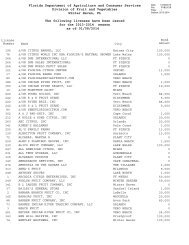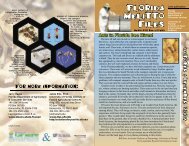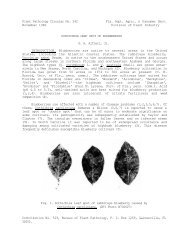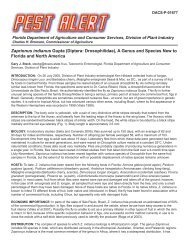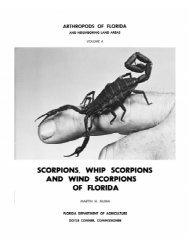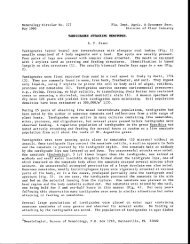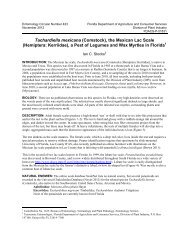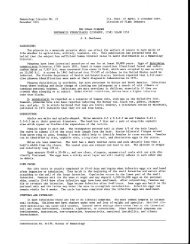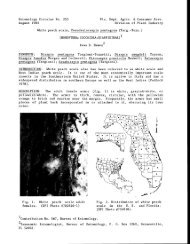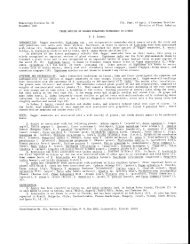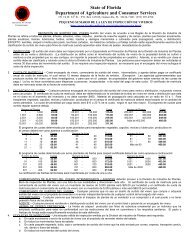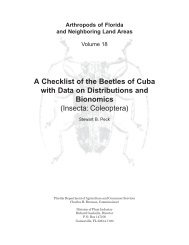Giant Palm Weevils of the Genus Rhynchophorus - Florida ...
Giant Palm Weevils of the Genus Rhynchophorus - Florida ...
Giant Palm Weevils of the Genus Rhynchophorus - Florida ...
You also want an ePaper? Increase the reach of your titles
YUMPU automatically turns print PDFs into web optimized ePapers that Google loves.
<strong>Giant</strong> <strong>Palm</strong> <strong>Weevils</strong> <strong>of</strong> <strong>the</strong> <strong>Genus</strong> <strong>Rhynchophorus</strong><br />
(Coleoptera: Curculionidae) and Their Threat to <strong>Florida</strong> <strong>Palm</strong>s<br />
Michael C. Thomas, Mike.Thomas@FreshFrom<strong>Florida</strong>.com, Taxonomic Entomologist, <strong>Florida</strong> Department <strong>of</strong> Agriculture<br />
and Consumer Services, Division <strong>of</strong> Plant Industry<br />
INTRODUCTION: The giant palm weevils <strong>of</strong> <strong>the</strong> genus <strong>Rhynchophorus</strong> Herbst are among <strong>the</strong> worst palm pests in <strong>the</strong><br />
world. One species, <strong>Rhynchophorus</strong> cruentatus (Fabricius), is native to <strong>Florida</strong> and <strong>the</strong> sou<strong>the</strong>astern US. Two o<strong>the</strong>r<br />
species, <strong>Rhynchophorus</strong> ferrugineus (Olivier) and <strong>Rhynchophorus</strong> palmarum (L.), are found in <strong>the</strong> New World and are<br />
considered to be threats to palms in <strong>Florida</strong>.<br />
Of particular concern is R. ferrugineus, known as <strong>the</strong> red palm weevil. It is a pest <strong>of</strong> coconut and o<strong>the</strong>r palms in its native<br />
range. Over <strong>the</strong> past three decades, its range has expanded into <strong>the</strong> Middle East, North Africa and Mediterranean Europe.<br />
It attacks many palm species, but is especially devastating on date palms. It recently became established in Curaçao<br />
in <strong>the</strong> Caribbean, placing it ever closer to <strong>Florida</strong>. In each case, it is suspected that <strong>the</strong> weevils travelled with imported<br />
palms. In January 2010, <strong>the</strong> federal government prohibited <strong>the</strong> importation into <strong>the</strong> United States <strong>of</strong> live palms belonging<br />
to 17 genera.<br />
IDENTIFICATION: Identifi cation <strong>of</strong> adult palm weevils is straightforward as <strong>the</strong>y are <strong>the</strong> largest weevils in North America,<br />
ranging from about 1 to 1.8 inches (25mm to 45mm) in length. The individual species are ra<strong>the</strong>r similar, but <strong>the</strong> three<br />
species under consideration can be distinguished by <strong>the</strong> following key:<br />
1. Pronotum strongly lobed posteriorly (Fig. 4, arrow); color black……………….R. palmarum<br />
— Pronotum evenly curved posteriorly (Fig. 3, arrow); color red, red and black, or black<br />
2. Pronotum gradually narrowed anteriorly (Fig. 1, arrow)………………………R. ferrugineus<br />
— Pronotum abruptly narrowed anteriorly (Fig. 2, arrow)………………………. R. cruentatus<br />
DACS-P-01682<br />
<strong>Florida</strong> Department <strong>of</strong> Agriculture and Consumer Services, Division <strong>of</strong> Plant Industry<br />
Charles H. Bronson, Commissioner <strong>of</strong> Agriculture<br />
BIOLOGY: Most <strong>of</strong> <strong>the</strong> information presented here was derived from Wattanapongsiri (1966). The female lays eggs at <strong>the</strong><br />
base <strong>of</strong> <strong>the</strong> leaf-sheath, terminal shoots, or in wounds or burrows made by o<strong>the</strong>r insects in <strong>the</strong> trunk. One female may lay<br />
more than 800 eggs. The eggs hatch in 3-4 days and <strong>the</strong> larvae burrow into <strong>the</strong> tree tissue, feeding for 25-105 days and<br />
undergoing 9-20 molts before preparing a pupal cell constructed from palm fi bers. Within <strong>the</strong> pupal cell, <strong>the</strong> larvae pass<br />
through a 2-17 day prepupal stage and <strong>the</strong>n an 8-50 day pupal stage. Adults may live more than 100 days. The total life<br />
cycle requires 45-180 days.<br />
HOSTS: The following host list for R. ferrugineus is from Malumphy and Moran (2007): The palms, Areca catechu,<br />
Arenga saccharifera, Arenga pinnata, Borassus fl abellifer, Borassus sp., Calamus merrillii, Caryota cumingii, Caryota<br />
maxima, Cocos nucifera, Corypha utan (= C. gebanga, C. elata), Corypha umbraculifer, Elaeis guineensis, Livistona<br />
decipiens, Livistonachinensis, Livistonac saribus (= Livistona cochinchinensis), Livistonac subglobosa, Metroxylon sagu,<br />
Oneosperma horrida, Oneosperma tigillarium, Phoenix canariensis, Phoenix dactylifera, Phoenix sylvestris, Oreodoxa<br />
regia, Sabal umbraculifera, Trachycarpus fortunei and Washingtonia sp., plus sugar cane, Saccharum <strong>of</strong>fi cinarum and<br />
century plant, Agave americana.<br />
Hosts for R. palmarum include Cocos nucifera, Elaeis guineensis, Euterpe edulis, Metroxylon sagu, Phoenix canariensis,<br />
Phoenix dactylifera, Saccharum <strong>of</strong>fi cinarum.<br />
<strong>Rhynchophorus</strong> cruentatus has <strong>the</strong> most restricted host range <strong>of</strong> <strong>the</strong> species considered here. Its native host is Sabal<br />
palmetto. Although it seems to mostly attack wounded or dying palms, it can be a severe pest <strong>of</strong> sabal palms in landscape<br />
situations, especially where newly planted trees are under stress. In <strong>Florida</strong>, it has occasionally reached severe pest
status on Phoenix canariensis in nurseries (Hunsberger et al. 2000). Hunsberger et al. (2000) and Division <strong>of</strong> Plant<br />
Industry records list o<strong>the</strong>r palm hosts as Bismarckia nobilis, Washingtonia sp., Serrenoa repens, P. dactylifera, Pritchardia<br />
sp., Roystonea sp., Cocos nucifera, Latania sp., Caryota sp., and Thrinax radiata.<br />
DISTRIBUTION: <strong>Rhynchophorus</strong> ferrugineus is native to sou<strong>the</strong>astern Asia and <strong>the</strong> Pacifi c Islands. It arrived in <strong>the</strong><br />
Arabian Peninsula in <strong>the</strong> 1980s and has since spread throughout <strong>the</strong> Middle East, North Africa, and Mediterranean<br />
Europe. It is a severe pest, especially <strong>of</strong> date palms, wherever it has been introduced. In late 2008, it was discovered on<br />
<strong>the</strong> island <strong>of</strong> Curaçao in <strong>the</strong> Dutch West Indies - <strong>the</strong> fi rst time it has been found in <strong>the</strong> New World. Malumphy and Moran<br />
(2007) gave its distribution as Bahrain, Bangladesh, Cambodia, China, Egypt, France, Greece, India, Indonesia, Iran, Iraq,<br />
Israel, Italy, Japan, Jordan, Kuwait, Laos, Malaysia, Myanmar (Burma), Oman, Pakistan, Palestinian Authority Territories,<br />
Papua New Guinea, Philippines, Qatar, Saudi Arabia, Solomon Islands, Spain, Turkey, Sri Lanka, Taiwan, Thailand,<br />
United Arab Emirates, Vietnam and Western Samoa.<br />
<strong>Rhynchophorus</strong> palmarum has been recorded (Anonymous 2005) from Argentina, Belize, Bolivia, Brazil, Colombia,<br />
Costa Rica, Cuba, Dominica, Ecuador, El Salvador, French Guiana, Grenada, Guadeloupe, Guatemala, Guyana,<br />
Honduras, Martinique, Mexico, Nicaragua, Panama, Paraguay, Peru, Puerto Rico, St. Vincent, Surinam, Trinidad and<br />
Tobago, Uruguay and Venezuela. Wattanapongsiri (1966) recorded R. palmarum from California and Texas based on<br />
perhaps doubtful records not supported by modern information. <strong>Rhynchophorus</strong> palmarum is <strong>the</strong> vector <strong>of</strong> <strong>the</strong> nematode<br />
Bursaphelenchus cocophius (Cobb) Baujard, which causes red-ring disease in coconut.<br />
<strong>Rhynchophorus</strong> cruentatus has been recorded from <strong>the</strong> sou<strong>the</strong>astern coastal plain <strong>of</strong> <strong>the</strong> United States (<strong>Florida</strong>, Georgia,<br />
South Carolina, Louisiana, Texas) (Wattanapongsiri 1966) and <strong>the</strong> Bahamas (Turnbow and Thomas 2008). In <strong>Florida</strong>, it<br />
occurs throughout <strong>the</strong> state (Woodruff 1967).<br />
REFERENCES:<br />
Anonymous. 2005. Data sheets on quarantine pests: <strong>Rhynchophorus</strong> palmarum. OEPP/EPPO Bulletin 35: 468–471.<br />
http://www.eppo.org/QUARANTINE/insects/<strong>Rhynchophorus</strong>_palmarum/DS_<strong>Rhynchophorus</strong>_palmarum.pdf<br />
[accessed February 4, 2010]<br />
Hunsberger, A.G.B., R.M. Giblin-Davis and T.J. Weissling. 2000. Symptoms and population dynamics <strong>of</strong> <strong>Rhynchophorus</strong><br />
cruentatus (Coleoptera: Curculionidae) in Canary Island date palms. <strong>Florida</strong> Entomologist 83: 290-303.<br />
Malumphy, C., and H. Moran. 2007. Red palm weevil <strong>Rhynchophorus</strong> ferrugineus. Central Science Laboratory Plant<br />
Pest Notice 5. http://faculty.ksu.edu.sa/10439/Documents/fi fty.pdf [accessed February 4, 2010]<br />
Turnbow, R. H., and M.C. Thomas. 2008. An annotated checklist <strong>of</strong> <strong>the</strong> Coleoptera (Insecta) <strong>of</strong> <strong>the</strong> Bahamas. Insecta<br />
Mundi 0034: 1-64.<br />
Wattanapongsiri, A. 1966. A revision <strong>of</strong> <strong>the</strong> genera <strong>Rhynchophorus</strong> and Dynamis (Coleoptera: Curculionidae). Department<br />
<strong>of</strong> Agriculture Science Bulletin, Vol. 1. Bangkok, 328 p.<br />
Woodruff, R. E. 1967. A giant palm weevil, Rynchophorus cruentatus (Fab.), in <strong>Florida</strong> (Coleoptera: Curculionidae). <strong>Florida</strong><br />
Department <strong>of</strong> Agriculture and Consumer Services, Division <strong>of</strong> Plant Industry. Entomology Circular No. 63: 1-2.<br />
1. 2.<br />
3.<br />
4.<br />
Figures 1-4. Adults <strong>of</strong> <strong>Rhynchophorus</strong> spp., illustrating diagnostic characters:<br />
1. R. ferrugineus; 2. R. cruentatus, red and black form; 3. R. cruentatus, black form; 4. R. palmarum.<br />
Pest Alert created 18-February-2010



